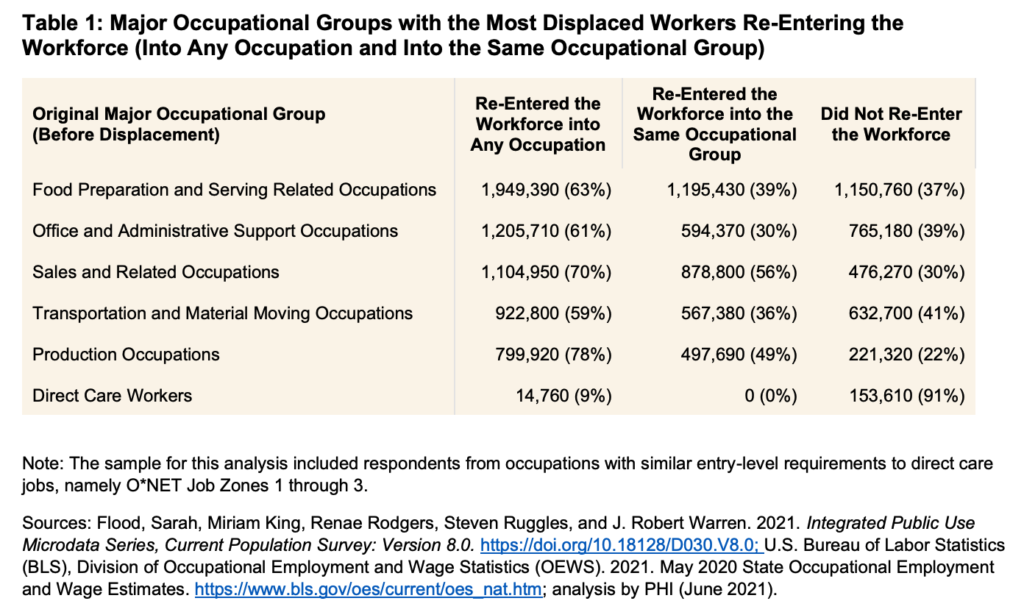Most in-home care providers tried searching for silver linings during the early days of the COVID-19 pandemic.
Despite the tragic circumstances, for example, some predicted that the economic instability caused by COVID-19 would translate into new recruitment opportunities for workforce-challenged providers.
“If restaurant and hospitality workers were laid off, maybe they would find a new career as caregivers,” the basic thought process went.
But those predictions haven’t turned into reality for direct care employers, a new report from PHI and the Health Workforce Research Center on Long-Term Care (HWRC) at the University of California, San Francisco, suggests.
“The overarching lesson from this report is our country’s leaders will need to transform the direct care workforce to ensure that employers can fill these jobs — now and in the decade ahead,” Kezia Scales, director of policy research at PHI and one of the report’s co-authors, said in a press release.
Broadly, “direct care workers” are individuals who provide regular, hands-on assistance to seniors and individuals with disabilities across a variety of settings, including the home.
During the first three months of the COVID-19 pandemic in 2020, about 13.7 million workers were displaced from occupations with similar entry-level requirements to direct care, according to the PHI-HWRC report. One year later, in early 2021, 9.1 million workers — or 66% of displaced workers — had re-entered the workforce.
“An immeasurably small” number of those displaced workers, from direct care or any occupation, were ultimately reemployed into direct care.
“The fact that few workers who lost jobs during the pandemic moved into open direct care jobs highlights the need to improve direct care jobs so they attract well-skilled and dedicated people to care for people who need their services,” Joanne Spetz, associate director for research at HWRC, said in the release.
Drilling further into the details of the data reinforces those points: While direct care employers failed to attract displaced workers from other occupations, they also failed to gain back the caregivers they initially lost.
By using a combination of data sources from the U.S. Census Bureau, the Bureau of Labor Statistics, the Occupational Information Network and elsewhere, PHI and HWRC researchers identified 168,370 direct care workers who were displaced from their jobs in the first three months of the COVID-19 emergency.
Of those individuals, just 14,760 — or 9% of them — reentered the workforce into any occupation.
Effectively none of those workers reentered the workforce back into a direct care job.
In comparison, among all workers who were reemployed, 44% reentered the workforce into the same occupation. Another 18% reentered the workforce into a different occupation within the same industry or profession.
“This research provides new insights on a long-standing question that has become even more urgent in the last two years: how do we recruit more workers into the direct care workforce to meet growing demand and avoid future tragedies?” Jodi M. Sturgeon, president of PHI, said in the release.
Generally, reemployed workers tended to earn higher wages and were more likely to work full time than direct care workers, PHI and HWRC found.
A previous PHI report estimated that long-term care employers will need to fill 7.4 million job openings in direct care from 2019 to 2029, including 1.3 million new jobs to meet rising demand and another 6.1 million jobs to replace workers who leave their positions.
“Considering the similarities that were identified between direct care and certain other occupations, this research also highlights the need to develop tailored recruitment messages that effectively reach workers who have been displaced from or may be seeking employment in those other occupations,” the new report reads. “For example, recruitment messages could highlight shared job characteristics, such as the customer service emphasis, the priority placed on teamwork, or the intrinsic value of caring for others, among others.”
Companies featured in this article:
Health Workforce Research Center on Long-Term Care, PHI, University of California-San Francisco





